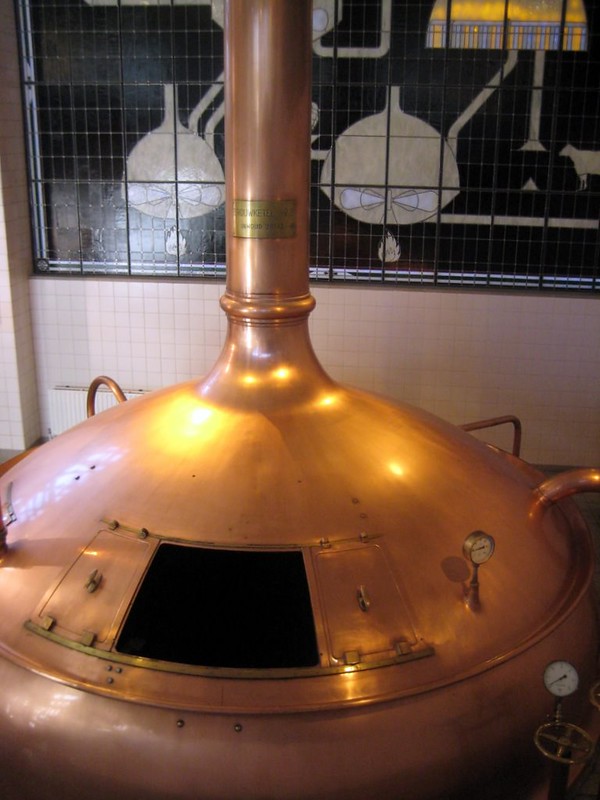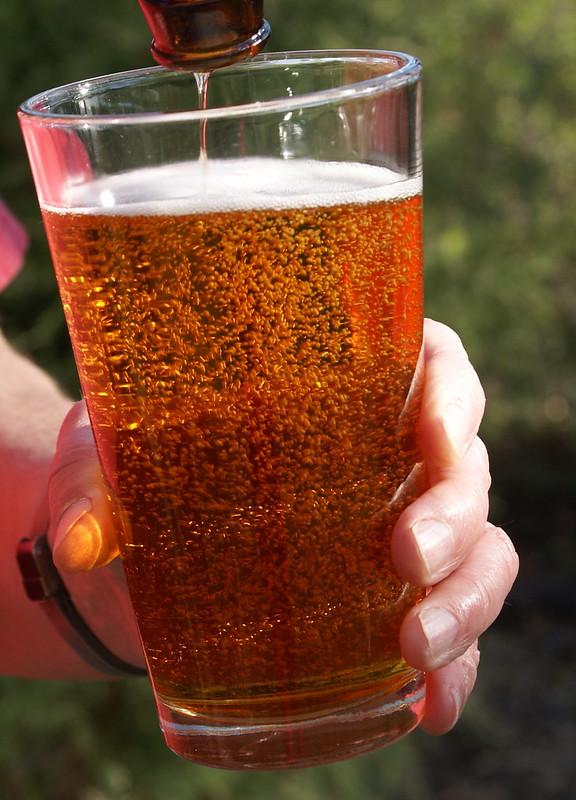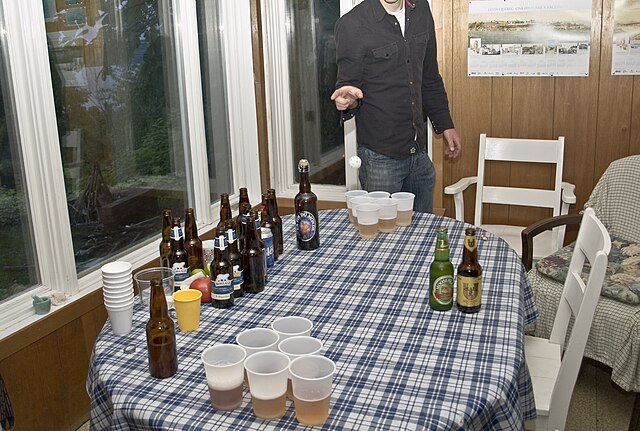Beer
Beer is the most popular alcoholic beverage. There is whole science involved in the world of beer. It is called zythology. It comes from two Greek words - zythos which is beer and logos which is word, principle.
The process of beer making is known as brewing. The patron saint of brewers is Saint Arnold of Metz (ca 582-640). There is one character that is often associated with beer. He is Gambrinus. He is an imaginary guy created in Belgium and the Netherlands of the middle ages.
 Copper kettle in brewery
Copper kettle in brewery
In brewing malted barley is fermented. Some breweries use wheat, corn or even rice instead of barley. Brewing also includes hops. Hops is added to give bitterness to beer but also as preservative. Off course no beverage is made without water. There are some beers that are made with various herbs or fruit.
Beer has some health benefits. Generally speaking they are more or less the same for all beers. Still considering the fact that some beers include various extra ingredients there are beers with more positive effects on your health.
Beer has different B vitamins like for example B6 and B12. As already mentioned beer is made of various types of grains, cereals. That is why there is some silicon in this beverage. Silicon has positive effect on one's bone matrix.
Beer helps to significantly lower risk of kidney stones. As beer contains alcohol moderate drinking of it can help you to avoid heart attack and similar diseases.
Beer is also the oldest alcoholic beverage. Beer was first mentioned in the Code of Hammurabi made in the Ancient Mesopotamia 1754 BC. There is no the exact proof but it is quite reasonable to claim that it is quite possible that people drank beer in the early Neolitic of 9500 BC. People started growing cereal crops then.
People in Ancient Egypt were drinking beer too. They learned to make beer from their god of agriculture Osiris.
Beer has a place in the Viking mythology. Vikings believed that brave death in a battle will enable going to Valhalla.. Among things vikings enjoyed there was beer. For this purpose there need a very special goat called Heiðrún. She has been eating leaves of the Laeraor tree. She did not have milk like an ordinary goat. She had beer.
The oldest still operating brewery is the German Weihenstephan Abbey. It is located in Bavaria and it has been making beer since 1040. In Belgium there are more than 800 different beers. The most beer per capita is drank in the Czech Republic (143 litres) and Germany (110 litres).
The most expensive beer in the World is from Belgium. A bottle of Vieille Bon Secours will cost you some 825 EUR. Each bottle has 12 litres. It has 8% of alcohol per volume. Before selling it has to mature for 10 years.
There are various types of beer. First of all there are ales and lagers. Technologically speaking the main difference between ales and lager is in the type of yeast used in brewing. Top-fermenting yeast (Saccharomyces cerevisiae) is used for ale while bottom-fermenting yeast (Saccharomyces uvarum) is present in brewing of lagers.
 Glass of Ale
Glass of Ale
Ale is characterized with sort of ``fruity'' taste. The word ``lager'' comes from German ``lagern'' which means to store. Long time ago during hot summer days Bavarians kept beer in cellars where the temperature was low. The most popular lagers are those pale ones. They are of light, yellowish colour.
Apart from ale and lager some other popular types of beer are stout, wheat, lambic etc.
Most beers have between 3 and 14% of alcohol by volume. The strongest beer available on the market is the Brewmeister´s ,,Snake Venom``. This Scottish beer has 67.5% of alcohol by volume.
Some people also love shandy which is a mixture of beer and some soft drink like for example lemon, orange or grape fruit juice.
Beer is sold in bottles, metal cans and metal kegs. Some people collect beer bottles. They are known as labeorphilists.
Perhaps only few of you have ever heard of the term cerevisaphile. It includes both beer fans and experts. For them a very important factor when you drink you glass of beer is the temperature. Already mentioned pale lagers are the best when served chilled. Beers with higher alcohol content should be drank at the room temperature.
Three major types of vessels are used for drinking of beer - a glass, stein (mug) and a pewter tankard.
They often have the brewery or beer logo on them. A stein can be made of porcelain, glass, silver or wood. In some situations people drink their beer just out of a bottle or can.
A beer coaster or mat is put under the vessel. This piece of paper or plastic can have round or rectangle shape. Its purpose is to protect the surface upon which the vessel is put. While drinking beer in the Czech Republic a beer pat has kind of special purpose. A bar tender will keep refilling your glass until you put a beer mat on it.
In Munich, Germany people often drink beer in beer halls and beer gardens. When in a beer hall it is common that tables are shared. That means you can not drink alone. On the other side you can always take a seat where there is some place. In case you see a brass plate next to a table that means that table is reserved for some event or there is group of people who meets and drinks there reguarly.
There is no bar tender so a waiter or waitress will bring you a beer. Beer is drank out of various vessels - 0.3, 0.5 or 1 litre vessels. This 1 litre vessel is called the mass.
Beer gardens often have nice surroundings. They are located next to a brewery often with a huge tree providing visitors with shade during hot summer afternoons. People can bring their own food to the venue. Still you can always buy some food on offer there.
One of the most famous German beers is Kölsch brewed in the region around German city of Cologne. It is required that this beer is drink at about 10°C. You must use as special narrow glass called ``stange'' (``pole''). Only 0.2 litres of beer can be poured into this glass.
Norwegians have been making their Christmas beer for centuries. The only time when there was no Christmas beer was the World War 2 and short period after it. The brewing of the beer started again in 1956. In the past this beer was called "pottøl" (``pot beer'') or "søttøl" (``sweet beer''). It is made to go well with delicacies served at the Christmas meal.
Similar to Norwegians Danes also love their Christmas beer. Every year the biggest Danish brewery Tuborg releases its own Christmas beer (``julebryg''). Among the local beer fans this day is known as the J-day. The tradition has been going on since 1990.
The J-day was not always held on the same day. From 2010 it is the first Friday in November. The beer is brought out to streets and markets in big trucks or horse driven carriages. The Christmas beer is offered to the gathered crowd for free at exactly 8:49 pm.
A group of people in Peru traditionally shares beer out of a single bottle which usually contains 0.65 litres of beer. There is only one glass. The first person in group is usually the one who bought the beer. This person pours beer in the glass. Then he or she gives the bottle to the next person. This person waits for the first one to drink beer. After that the second person pours the beer and then gives the bottle to the third person etc.
There are some rather unusual beer vessels used in games played in a pub. In the United Kingdom there is a glass known as the yard of ale or yard glass. It is ball shaped at its bottom. From top of this ball there is kind of tube that gets wider towards the top of the glass.
The glass is about 0.91 m (1 yard) long. It can contain about 1.42 litres of beer. People compete who is going to drink all the beer out of the yard glass faster. In New Zealand this glass is known as the ``yardie''. It is part of the coming of age ritual when people celebrate their 21st birthday.
A pub game that also include beer is ``beer pong'' or ``Beirut''. 6-10 cups (``makes'') filled with beer are set in a triangle shape. There is a triangle on two opposite sides of a table. A player tries to throw a ping pong ball into some of the cups in the opponent's triangle. When successful she or he has to drink up the beer from that cup.
 Beer Pong
Beer Pong
There are games with beer held in the nature. A beer mile is competition combining running and drinking of beer. The competition usually includes four rounds of 400 metres. Before the race and after each round a competitor drinks 355 ml of beer. Rules actually vary according to part of the World where the competition is held.
Beer fans all over the World get together at various festivals. There is one that can be regarded as synonym for such an event. It is the legendary Oktoberfest held at the area called Theresienwiese in Munich, Germany. That is why the Oktoberfest is sometimes known as the Wiesen. This 16 days long event lasts from mid September until the first week of October. The first Oktoberfest was the one in 1810.
Only breweries from Munich can sell their beer at the Oktoberfest. The second criteria is that they brew their beer according to the Reinheitsgebot or the "German Beer Purity Law''. These breweries are Augustiner-Bräu, Hacker-Pschorr-Bräu, Löwenbräu, Paulaner, Spatenbräu, and Staatliches Hofbräu-München. Alcoholic beverages are available in 14 big tents. Beer is sold in most of them but in ``Weinzelt'' (``Wine Tent'') you can also drink wine.
Oktoberfest is a paradise for beer lovers. Lot of traditional food is on offer too. You can try local delicacies like for example würstl (sausage), brezen (pretzel), hendl (rosted chicken) etc.
References Beer https://en.wikipedia.org/wiki/Beer Code of Hammurabi https://en.wikipedia.org/wiki/Code_of_Hammurabi 25 Interesting Beer Facts That Will Leave You Tipsy http://list25.com/25-interesting-beer-facts-that-will-leave-you-tipsy/ Fred Eckhardt, Lager Beer vs. Ale Beer - Does it Matter? http://allaboutbeer.com/article/lager-beer-vs-ale-beer%E2%80%94does-it-matter/ Ale https://en.wikipedia.org/wiki/Ale Beer stein https://en.wikipedia.org/wiki/Beer_stein Beverage coaster https://en.wikipedia.org/wiki/Beverage_coaster Beer trivia http://www.geniusofdrinking.com/drinking-101/beer/trivia.html Beer pong https://en.wikipedia.org/wiki/Beer_pong List of Belgian beers http://www.eupedia.com/belgium/belgian_beers.shtml Samantha Payne, Top 10 Heaviest Beer-drinking Countries: Czech Republic and Germany Sink Most Pints http://www.ibtimes.co.uk/top-10-heaviest-beer-drinking-countries-czech-republic-germany-sink-most-pints-1475764 David Joshua Jennings, Never Fill Your Own Glass: 20 Foreign Drinking Rules and Customs You Need to Know http://www.bootsnall.com/articles/11-12/20-drinking-traditions-from-around-the-world.html Norway's tradition of brewing Christmas beer http://www.news-medical.net/news/20151228/Norwaye28099s-tradition-of-brewing-Christmas-beer.aspx Most Expensive Beer - Vieille Bon Secours Ale http://dolchino.com/most-expensive-beer-vieille-bon-secours-ale.html Weihenstephan Abbey https://en.wikipedia.org/wiki/Weihenstephan_Abbey Dead Vikings Got Endless Beer - From Goats http://vinepair.com/wine-blog/dead-vikings-got-endless-beer-from-goats/ Beer History - Facts & Trivia https://www.beerfestboots.com/beer_trivia Gambrinus https://en.wikipedia.org/wiki/Gambrinus Mastering beer hall etiquette in Munich http://www.simonseeks.com/travel-guides/mastering-beer-hall-etiquette-munich__111264 Germany Tipping & Etiquette http://www.tripadvisor.com/Travel-g187275-s606/Germany:Tipping.And.Etiquette.html J-day in Denmark http://www.thelocal.dk/20151104/j-day-denmarks-unofficial-start-to-the-holidays Beer mile https://en.wikipedia.org/wiki/Beer_mile Shandy https://en.wikipedia.org/wiki/Shandy The Peruvian Beer-Drinking Tradition http://howtoperu.com/2011/10/20/peruvian-beer-drinking-tradition/ Yard of ale https://en.wikipedia.org/wiki/Yard_of_ale Susan Scutti, 4 Health Benefits Of Beer Drinking: Antioxidants, B-Vitamin, And Protein Are There... But Don't Overdo It http://www.medicaldaily.com/4-health-benefits-beer-drinking-antioxidants-b-vitamin-and-protein-are-there-dont-overdo-it-258658 Oktoberfest https://en.wikipedia.org/wiki/Oktoberfest Images Copper kettle in brewery (photo by Laura, Flickr) https://www.flickr.com/photos/tigergirl/4093239279/ Goat Heiðrún eating the foliage of the tree Læraðr, from an Icelandic 18th century manuscript (photo by Jakob Sigurðsson, Wikimedia) https://commons.wikimedia.org/wiki/File:S%C3%81M_66,_73r,_Hei%C3%B0r%C3%BAn.jpg Ale (photo by Sarah, Flickr) https://www.flickr.com/photos/stardark1/5503669399/ Kölsch (photo by Shankar S., Flickr) https://www.flickr.com/photos/shankaronline/7225623762/in/photolist-c1vdd3 Yard of ale competition (photo by Let's go out Bournemouth and Poole, Flickr) https://www.flickr.com/photos/letsgoout-bournemouthandpoole/7746359962 Beer Pong (photo by Jean-Philippe Caissy, Wikimedia) https://commons.wikimedia.org/wiki/File:Partie_de_Beer_Pong.jpg Löwenbräu tent at the Oktoberfest, 2012 (photo by Bayreuth2009, Wikimedia) https://commons.wikimedia.org/wiki/File:M%C3%BCnchen,_L%C3%B6wenbr%C3%A4u-Festhalle,_Oktoberfest_2012_%2803%29.jpg